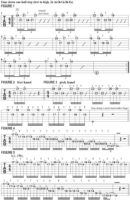
Tapped Out: More Creative Uses for Percussive Tapping
As I’ve stated in previous columns, one of my favorite techniques for performing fast, complex melodic lines is what I like to call percussive tapping. The concept is to alternate tapped figures executed with each hand individually, oftentimes with more than one fret-hand finger brought into play.
To my way of thinking, the idea is virtually the same as the manner by which a drummer will play varying rhythmic syncopations on a given drum or drums. The integration of the movement of the two hands creates the rhythmic syncopation; the added benefit here is that the guitar is a melodic instrument, and the technique allows one to play phrases that would otherwise be impossible. I love the way drummers use triplets, “quads” (four-note groups) and more unusual rhythmic patterns and find it endlessly fascinating to try and apply this approach to melodic ideas on the guitar.
Use a staccato (short and clipped) articulation for the examples presented herein. The pick hand needs to use more of a “punch” in the way the taps are executed, and the fret hand “rolls” between two taps, or “hammer-ons from nowhere,” which must be applied quickly and with precision.
For our first example, FIGURE 1, notes are sounded on the G and high E strings only, played in a rhythm of fast 16th-note triplets. Throughout the pattern, the fret-hand index finger taps a note on the G string, followed by the middle finger tapping the high E string at the same fret, as shown in FIGURE 2. In this example, these initial “taps” first occur at the 21st fret.
Prior to applying the fret-hand taps, the pick hand taps a single note, first on the high E string, and then one on the G string; these initial taps occur three frets higher, at the 24th fret, as shown in FIGURE 3. In bars 1–4, each 16th-note triplet is played four times before it descends chromatically. The single pick-hand note moves down one fret, followed by the two fret-hand notes, which also move down one fret. In bars 5 and 6, the 16th-note triplets are only played twice before they descend chromatically.
This technique can easily be applied to patterns based on scales such as minor pentatonic. In FIGURE 4, I rapidly move between single taps with each hand, forming the “box” shape of the F# minor pentatonic scale in 14th position. I begin with the pick-hand tap, followed by the fret-hand tap on the next lower scale degree, alternating between the two continually through the lick. Another neat twist, shown in FIGURE 5, is to stay on the top two strings and change the pick-hand note before descending through the pattern.
Now that you have the idea, try devising some percussive tapping licks of your own, applying the concept and technique to different scales and areas of the fretboard.
Source: www.guitarworld.com












